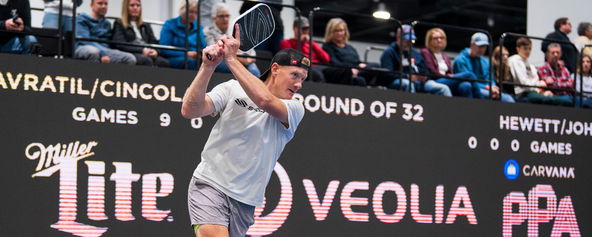
The shot that is changing pro pickleball
Jim Kloss
Oct 15, 2024 08:15 AM ET
Pro pickleball doesn't look the same as it did five years ago; similarly, pro pickleball (to the extent it existed), in 2014 looked different than it did in 2019. Pickleball is constantly changing and evolving, and even though the court and the net do not change, the shots do change and the game is different over time. Watch a match from 5-10 years ago, and you can see the differences manifest themselves over time.
What is happening now? How is the game changing? What will pro pickleball look like in 2029, and how will it be different from today’s game?
One of the biggest changes of the last five years is the growth of the twoey, the two-handed backhand. Five years ago, the twoey was very rarely used. Today, the twoey is commonplace, especially in the women’s game, especially from the baseline. We even see players who up to now have been exclusively using the one-hand backhand now throwing in an occasional twoey; players such as Ben Johns and Federico Staksrud come to mind. Go back just a year, and it is difficult if not impossible to find Johns or Staksrud hitting a twoey; today, both will even use it at times on dinks.
One of the biggest changes of the last five years is the growth of the twoey, the two-handed backhand. Five years ago, the twoey was very rarely used. Today, the twoey is commonplace, especially in the women’s game, especially from the baseline. We even see players who up to now have been exclusively using the one-hand backhand now throwing in an occasional twoey; players such as Ben Johns and Federico Staksrud come to mind. Go back just a year, and it is difficult if not impossible to find Johns or Staksrud hitting a twoey; today, both will even use it at times on dinks.
ADVERTISEMENT
The twoey is changing the game. And the change has not ended. I believe the biggest change we will see over the next five years will be the twoey taking over completely or very nearly so. The number of players who predominantly use the two-handed backhand now approaches 50%; it may well be over 50% on the women’s side.
More specifically, the change will become most pronounced in the dink game. And you can thank one person; Quang Duong. Duong has long been a twoey guy, but his twoey dinks are what is really going to change the game. If you did not see it, go watch the Bristol Open final, where Duong and Christian Alshon defeated the Johns brothers. Duong, playing the left side, hit offensive twoey dinks, crosscourt. We have seen crosscourt twoey dinks before, from players such as Riley Newman and James Ignatowich, but those dinks are relatively soft, albeit with some topspin. Duong’s twoey dinks are different; he drives them. They are lower and harder and they can get behind the opponent. We saw that in the Bristol final, where Duong was able to get a few behind Ben Johns, something almost unheard of.
Trust me, the players all recognize this trend and are working on it. For example, at the recent Las Vegas tounrament, I asked Dylan Frazier, a one-hand backhand guy, about the twoey. He said he is working on it, due in part to what he saw from Duong at Bristol. The idea behind it, as Dylan talked about, was to provide a new avenue for offense. Dinking to the opponent’s backhand has long been the safe shot; put it there and you are in the safe zone. No more; not if the opponent can speed it up off the twoey or roll it crosscourt with force.
My prediction is that if/when we look at pro pickleball in 2029, the player with the one-hand backhand will be the oddity. Everyone or just about everyone will be hitting twoeys. We will also see them hitting aggressive crosscourt rolls, trying to get it behind the opponent. Watch for this trend. Better yet, start practicing the twoey yourself and get ahead of the curve, as the twoey is coming for you from your opponents.
Follow me on Twitter/x @pickleball_jim
Related articles

Five game-changing tips to elevate your pickleball skills
Learn from one of the best coaching minds in the business, John Cincola.
21 days ago
-Victoria Radnothy

The history of the two-handed backhand: From underused to overused
Too many players, especially juniors, are using the shot on all or many volleys.
37 days ago
-Jim Kloss

Zane Navratil teaches wrist lag to generate power in pickleball
This may just be the key ingredient your game is missing.
60 days ago
-Victoria Radnothy

How to hit an aggressive forehand roll
Everything you need to know to put pressure on your opponents at the net.
168 days ago
-Victoria Radnothy





